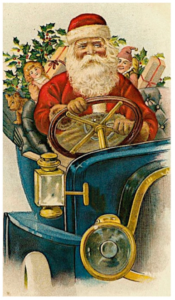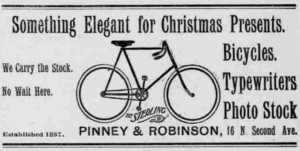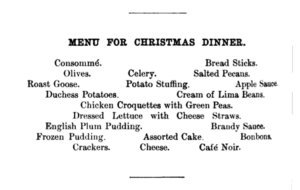Christmas in Victorian Phoenix
Did you know…
 As we make our way through the season, decking the halls within an inch of their lives and singing along with 24/7 Christmas radio stations, it’s interesting to look back and see how the holidays were celebrated at the turn of the century. We’ve looked through several issues of the Arizona Republican newspaper (now the Arizona Republic) to get a better idea of how the people who lived in the Rosson House experienced the holidays. Here’s what we found:
As we make our way through the season, decking the halls within an inch of their lives and singing along with 24/7 Christmas radio stations, it’s interesting to look back and see how the holidays were celebrated at the turn of the century. We’ve looked through several issues of the Arizona Republican newspaper (now the Arizona Republic) to get a better idea of how the people who lived in the Rosson House experienced the holidays. Here’s what we found:
- Like us, Victorian Phoenicians liked to exchange presents. Ads for gifts generally appeared in the newspaper around the beginning of December. Stores like The Irvine Co. at 35 E. Washington St. promoted Christmas cards (which were considered gifts), toys, dolls, games, books, photo albums, cactus ware, fountain pens and novelties. Clothing, linens and handkerchiefs were also favored gifts, as were bicycles and jewelry. Food was often exchanged as well, and candies, oranges, apples and nuts were added to children’s stockings. In 1895, City Marshal Gus Clark gave his deputies a “handsome diamond pin and…a diamond scarf pin as a reward for efficient and faithful services”.
- Fresh greenery (including evergreens, palm leaves, mistletoe, holly, and pepper branches), red roses and carnations were used to decorate everything from homes to churches to country clubs. Christmas trees were decorated with small gifts, home made and purchased ornaments, and with candles or electric lights. Early Phoenix settlers even decorated a deciduous tree on the corner of Center and Washington Streets with joke gifts – individuals would stop by, find their nametag, and take their gift. The funniest was said to be the overlarge pair of scissors gifted to the editor of the newspaper.

- Donations were made to charities at Christmas, so that everyone could enjoy the holidays. The Salvation Army took donations of food from local grocery stores, bakeries, butchers, and restaurants for the poor. Even the residents at the Arizona Insane Asylum got to celebrate the holidays – they enjoyed a Christmas tree; seasonal music (they had their own orchestra!); gifts of handkerchiefs, nuts, candies, apples and oranges; and later they ate a turkey and duck for dinner.
- You can’t celebrate the holidays without food, and turn of the century Phoenicians weren’t ones to shy from that kind of party! Christmas dinners were special, and so, were more extravagant. If they could afford to, people would go to a restaurant for their holiday meal. The Hotel Adams, the Ford Hotel, Hotel Hardwick, and the Opera House Café all listed their menus in the December 25, 1896 edition of the newspaper. The menus listed anywhere from six to eight different courses, and include caviar, oysters,

A suggested menu for Christmas dinner, from the 1896 Fanny Farmer Cookbook.
consommé, green turtle soup, lobster bisque, olives, halibut, roasts, turkey, venison, quail, duck, potatoes, asparagus, cauliflower, peas, tomatoes, waffles, puddings, sweetbreads, pies, ice cream, lady fingers, macaroons, fruit, walnuts, almonds, candied raisins, cheese, crackers, and coffee. The courses were small, but that is still a lot of food!
You can find out more about Victorian holiday decorations from our December 2017 blog article, Decking the Halls, and about how they lit their Christmas trees from our December 2016 blog article, Lighting Up the Holidays. In that same vein, read Smithsonian Magazine’s great article, The History of the Christmas Card – it’s just what you need to procrastinate filling out your own holiday cards!
Whether you’re a procrastinator or not (and we definitely are) – have a happy and healthy holiday, and we hope to see you soon at the Square!
Information about historic Christmas in Phoenix from the Library of Congress Chronicling America digital archives; Arizona Republican; December 23-28, 1891-1896.
Archive
-
2024
-
July (1)
-
June (1)
-
May (1)
-
April (1)
-
March (1)
-
February (1)
-
January (1)
-
-
2023
-
December (1)
-
November (1)
-
October (1)
-
September (1)
-
August (1)
-
July (1)
-
June (1)
-
May (1)
-
April (1)
-
March (1)
-
February (1)
-
January (1)
-
-
2022
-
December (1)
-
November (1)
-
October (1)
-
September (1)
-
August (1)
-
July (1)
-
June (1)
-
May (1)
-
April (1)
-
-
2021
-
December (1)
-
November (1)
-
October (1)
-
September (1)
-
August (1)
-
July (1)
-
June (1)
-
May (1)
-
April (1)
-
March (1)
-
February (1)
-
January (1)
-
-
2020
-
December (1)
-
November (1)
-
October (1)
-
September (1)
-
August (1)
-
July (1)
-
June (1)
-
May (1)
-
April (1)
-
March (1)
-
February (1)
-
January (1)
-
-
2019
-
December (1)
-
November (1)
-
October (1)
-
September (1)
-
August (1)
-
July (1)
-
June (1)
-
May (1)
-
April (1)
-
March (1)
-
February (1)
-
January (1)
-
-
2018
-
December (1)
-
November (1)
-
October (1)
-
September (1)
-
August (1)
-
July (1)
-
May (1)
-
April (1)
-
March (1)
-
February (1)
-
January (1)
-
-
2017
-
December (1)
-
November (1)
-
October (1)
-
September (1)
-
August (1)
-
July (1)
-
June (1)
-
May (1)
-
April (1)
-
March (1)
-
February (1)
-
January (1)
-
-
2016
-
December (1)
-
-
2015
-
2014
-
July (1)
-
